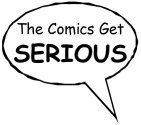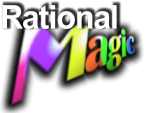

| JLA: Rock of Ages. Written by Grant Morrison. Pencilled by Howard Porter and others. Inked by John Dell and others. New York: DC Comics, 1998. 157p. $9.95. ISBN 1-56389-416-5. |
|
GENRES: AUDIENCE: NOTE: This book collects issues 10-15 of JLA. SYNOPSIS: Trouble: Lex Luthor has a peculiar stone (later called the Philosopher's Stone) that seems to respond to his wishes. The New God Metron, or an evil version of him, shows up to warn the JLAers left behind in their space station that the stone must be found, and that it must not be destroyed. After some adventures that are merely hinted at, Green Lantern, the Flash, and Aquaman return from far in the future to an Earth in which Darkseid rules. Turns out that the destruction of the stone some years ago set in motion the forces that would allow Darkseid to take over and transform the Earth. Can the returned heroes, trapped in elderly bodies, do something to get home and send a message to the other heroes that the stone is not to be destroyed? And can the other heroes successfully defeat Lex and his nasties? EVALUATION: Although this book is overall more coherent than DC One Million, it's still confusing and hard to follow. There's way, way too much going on, especially given the missing parts of the story. Did Morrison have these two completely unrelated plots that he felt compelled to juxtapose? I can't see any rational purpose in having these two different storylines taking place at the same time, except to get some of the JLA members out of the way so that they didn't completely overpower the Injustice Gang, who are really quite feeble; they literally stand around while their enemies appear in their midst. And some of the things that happened were just ridiculous. Why on earth would Luthor believe that a JLA member would come to his side for any reason? Why doesn't he play with the stone more? What was the purpose of the anti-JLA besides wreaking havoc? (The notion that the anti-JLA was studying the moves of the heroes is a ridiculous one, as this knowledge was never put into use; the whole scene was obviously just an excuse for a superbattle, since there's relatively little fighting through the rest of the book.) How did the destruction of the Philosopher's Stone result in Darkseid's ascendance? Why was Metron so dense that he could be talked into making himself human in front of hostile superheroes? And can there be any stupider concept than Death on skis? The dull, cliched, and unrealistic dialogue doesn't help. It's hard to believe that this is the same man who wrote "The Coyote Gospel" years ago. I suppose there's little one can do to make Superman or Darkseid more than the tired old cliches they've become, but the glimmers of personality that the other characters show are never fully drawn out. Aztek is an utter nonentity, and Plastic Man is forced and phony. The art--who cares? It's standard superhero stuff, with posey characters and glitz substituting for creativity. Even the Darkseid-twisted Earth is uninteresting, a wimpy ripoff of countless superior blasted cityscapes. This isn't a graphic novel; this is a marketing strategy. Absolutely not recommended. |
Return to Rational Magic Home
